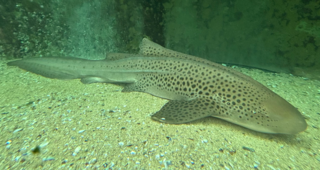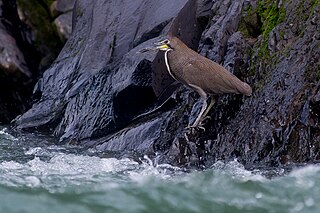
Carpet sharks are sharks classified in the order Orectolobiformes. Sometimes the common name "carpet shark" is used interchangeably with "wobbegong", which is the common name of sharks in the family Orectolobidae. Carpet sharks have five gill slits, two spineless dorsal fins, and a small mouth that does not extend past the eyes. Many species have barbels.

The zebra shark is a species of carpet shark and the sole member of the family Stegostomatidae. It is found throughout the tropical Indo-Pacific, frequenting coral reefs and sandy flats to a depth of 62 m (203 ft). Adult zebra sharks are distinctive in appearance, with five longitudinal ridges on a cylindrical body, a low caudal fin comprising nearly half the total length, and usually a pattern of dark spots on a pale background. Young zebra sharks under 50–90 cm (20–35 in) long have a completely different pattern, consisting of light vertical stripes on a brown background, and lack the ridges. This species attains a length of 2.5 m (8.2 ft).
Local extinction, also extirpation, is the termination of a species in a chosen geographic area of study, though it still exists elsewhere. Local extinctions are contrasted with global extinctions.

Pseudoplatystoma is a genus of several South American catfish species of family Pimelodidae. The species are known by a number of different common names. They typically inhabit major rivers where they prefer the main channels and tend to stay at maximum depth, but some species can also be seen in lakes, flooded forests, and other freshwater habitats. They have robust bodies, and are important food fish. Recently, their population size has been on the drastic decline due to a variety of factors including overfishing and habitat destruction due to the construction of hydroelectric dams.

The Serra do Cipó National Park is a national park in the state of Minas Gerais, Brazil.

The nurse shark is an elasmobranch fish in the family Ginglymostomatidae. The conservation status of the nurse shark is globally assessed as Vulnerable in the IUCN List of Threatened Species. They are considered to be a species of least concern in the United States and in The Bahamas, but considered to be near threatened in the western Atlantic Ocean because of their vulnerable status in South America and reported threats throughout many areas of Central America and the Caribbean. They are directly targeted in some fisheries and considered by-catch in others.

The reticulated swellshark is a catshark of the family Scyliorhinidae. The Reticulated swellshark is found in the western Pacific Ocean between latitudes 21° N and 28° S, at depths between 220 and 450 m. It is a blunt snouted shark with an inflatable stomach, narrow eye slits and a pattern of spots and lines covering its body. It can grow up to 80 cm in length.

The fasciated tiger heron is a species of heron in the family Ardeidae. It is present in southern Central America and parts of northern and central South America, where its natural habitat is rivers.

Saint-Hilaire/Lange National Park is a national park in Paraná, Brazil.

The band-winged meadowhawk is a dragonfly of the genus Sympetrum belonging to the family Libellulidae.

The Australian reticulate swellshark is a little-known species of catshark in the family Scyliorhinidae. It is found off the coast of northwestern Australia at depths of 290–420 m (950–1,380 ft). This shark has a stocky body and a short, wide head with a capacious mouth. It is characterized by a striking dorsal color pattern of dark brown lines that trace a series of hollow saddles and narrow rings, on a light background. Like other swellsharks, this species can inflate itself when threatened. Its reproduction is oviparous.

Characidium is a genus of fish in the family Crenuchidae. They are mainly found in South America, but C. marshi is from Panama. They are small, slender fish that live on the bottom in flowing fresh waters and feed on small animals such as insects.
Characidium sterbai is a species of South American darter endemic to Peru where it is found in the upper Amazon River basin.
Enneapterygius fasciatus, known commonly as the tiny threefin or the banded triplefin, is a species of triplefin blenny in the genus Enneapterygius. It was originally described by Weber in 1909, under the name Tripterygium fasciatum, which was later renamed Tripterygion fasciatum. It is a tropical blenny found in coral reefs in the Indian and western Pacific Oceans, and has been described from East Africa to Papua New Guinea, the Solomon Islands, and Taiwan. E. fasciatus has been recorded swimming at a depth range of 1–25 metres (3.3–82 ft). Male E. fasciatus can reach a maximum length of 3 centimetres.

Ectrepopterus uruguayensis is a small species of characin originally recorded only from streams in Uruguay, with occasional sightings in Brazil and Argentina. It is the only known member of the genus Ectrepopterus, which was formerly a subgenus of Megalamphodus. Given its restricted range, it is considered a rare fish, and is of note for conservation researchers interested in preserving the biodiversity of the region.
The banded japalure is a species of lizard. It is found in northern Vietnam and Sichuan, Chongqing, Guizhou and Guangxi of China, at elevations of 800–2,000 m (2,600–6,600 ft). Its habitat is montane forests. Its snout-vent length is 7.5 cm (3.0 in). The IUCN Red List of Threatened Species has assessed the species to be of least concern.
Pareiorhina cepta is a species of catfish in the family Loricariidae. It is native to South America, where it occurs in the São Francisco River basin in the state of Minas Gerais in Brazil. It is known to occur alongside the species Astyanax rivularis, Characidium fasciatum, Neoplecostomus franciscoensis, and Trichomycterus macrotrichopterus. The species reaches 4.4 cm (1.7 in) in standard length.

Pareiorhina hyptiorhachis is a species of catfish in the family Loricariidae. It is native to South America, where it occurs in the basins of the Pomba River and the Paraíba do Sul in Brazil. It is typically found in small streams with moderate to fast flow, margins covered in aquatic vegetation, and a substrate composed of rocks and sand. It is known to occur alongside the species Geophagus brasiliensis and Neoplecostomus microps, as well as members of the genera Astyanax, Characidium, Harttia, Imparfinis, and Trichomycterus. The species reaches 3.9 cm (1.5 in) in standard length.

Cheilotrema is a genus of marine ray-finned fishes belonging to the family Sciaenidae, the drums and croakers. These fishes are found in the eastern Pacific Ocean.















